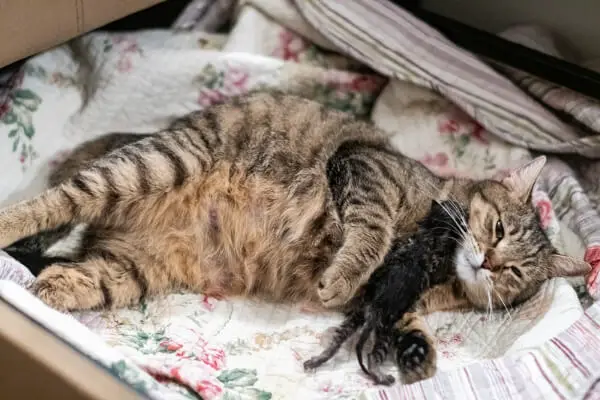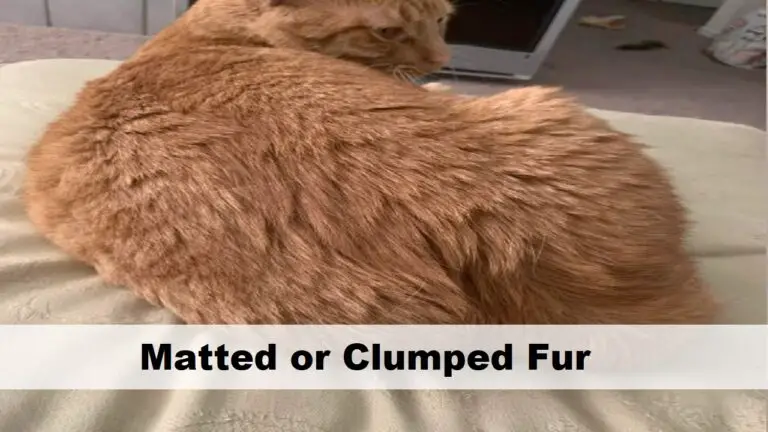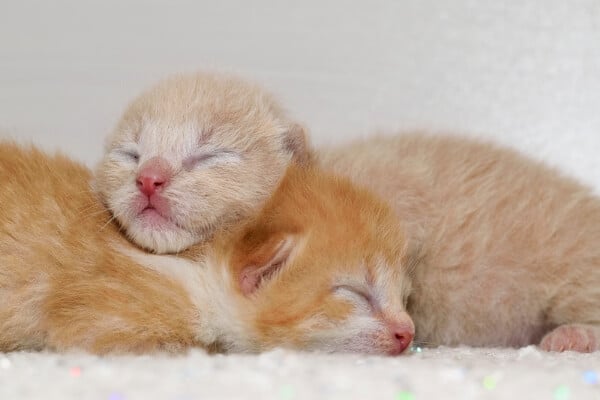How Long A Cat Should Wear A Cone After Neutering, Spaying, or Surgery?
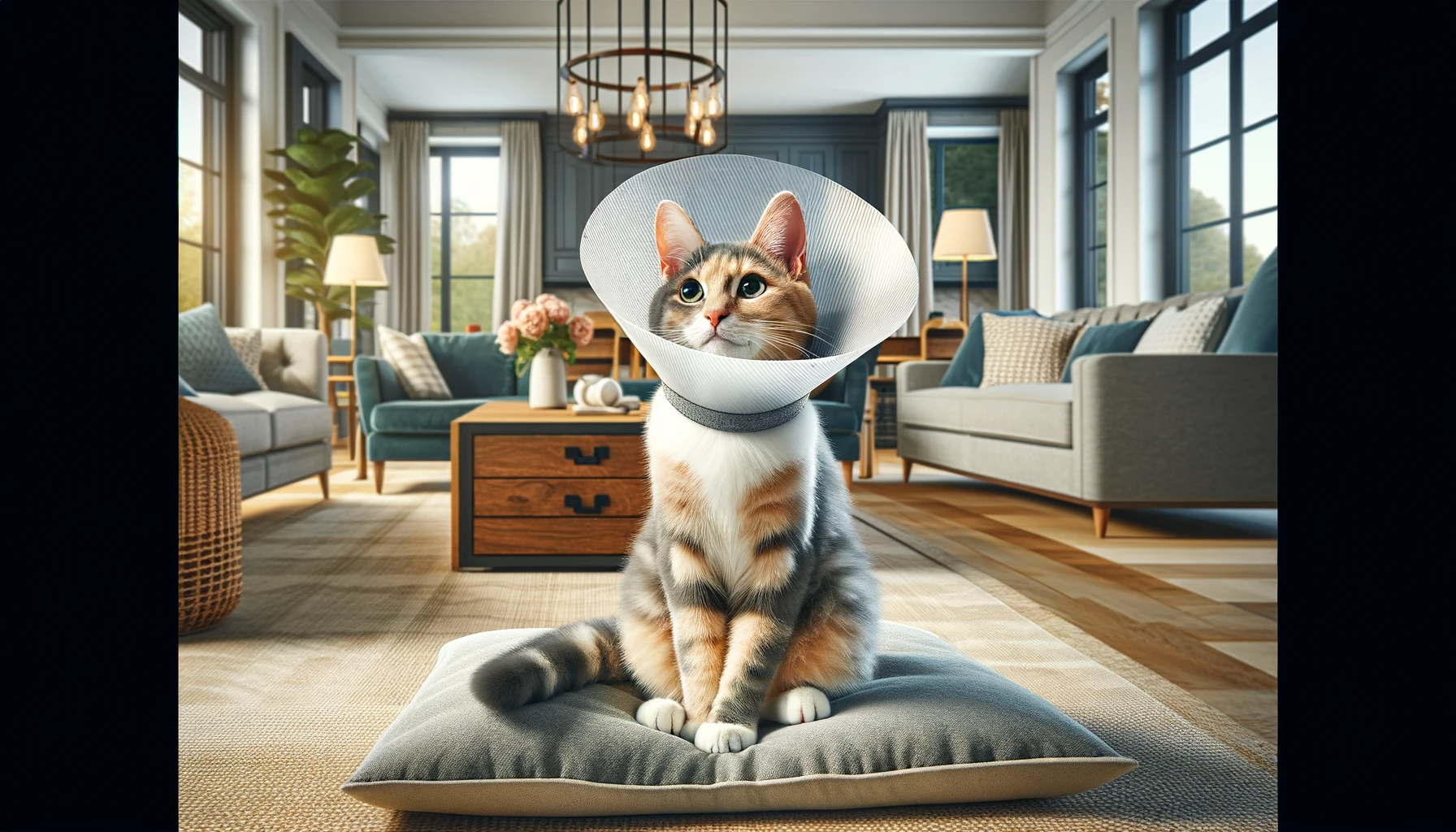
The recommended duration for your cat to wear a cone after neutering is typically 5-7 days, and after spaying is around 10-14 days.
Have you ever seen your cat with a cone and wondered why it’s necessary? You’re not alone! As a pet parent, I know how important it is to understand every aspect of our furry friends’ lives, especially when it comes to their health.
What is the Purpose of the Cone on Cats?
The primary role of a cat cone, or Elizabethan Collar (E-collar), is to safeguard your cat from harming itself post-surgery. Whether it’s an incision, lesion, staples, or surgical sutures, the cone prevents your cat from licking, biting, or pawing at these sensitive areas, which could lead to complications like infection.
Cats’ saliva isn’t conducive to healing; it can actually make the skin dry and fissured, creating a breeding ground for bacteria. The roughness of their tongue can easily damage healing tissue, and nibbling or chewing can delay the healing process significantly.
When Does Your Cat Need a Cone?
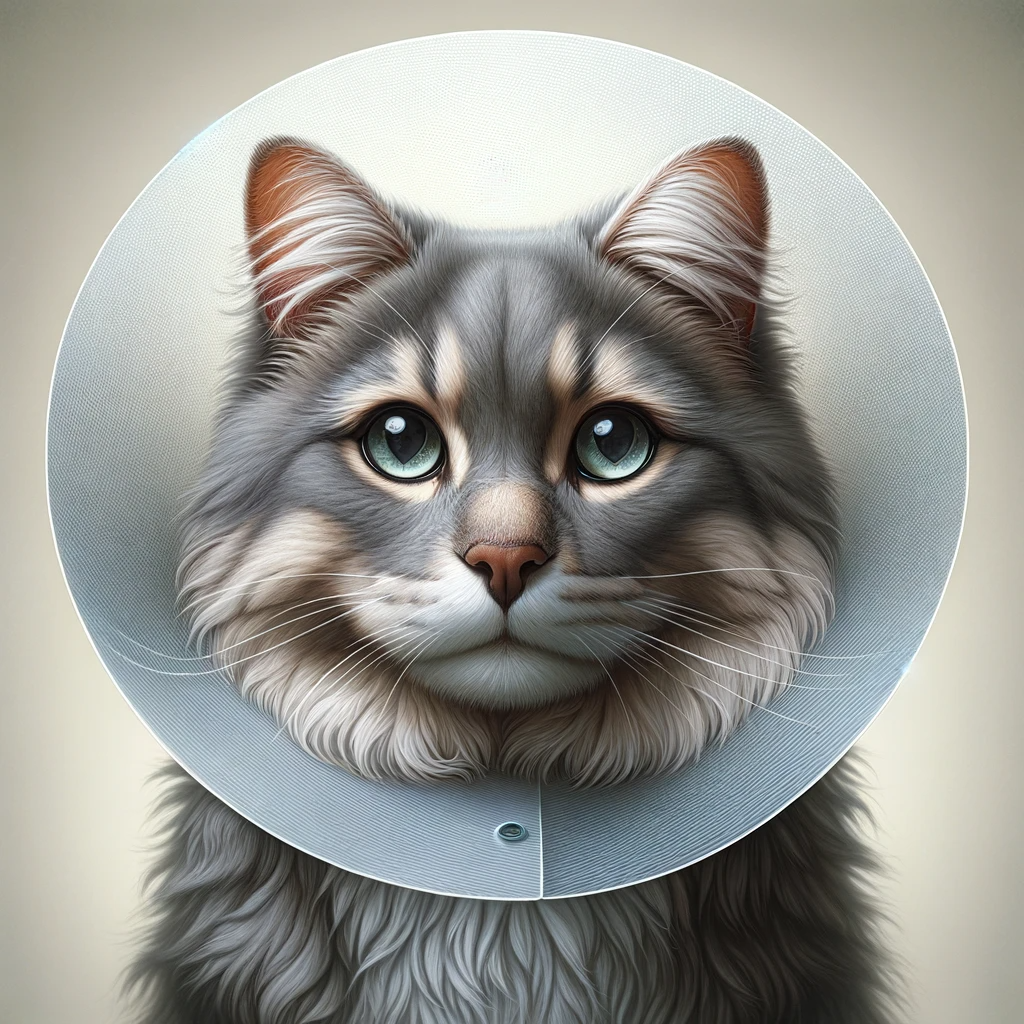
Cats typically require a cone after surgical procedures like spaying, neutering, or any other operation involving incisions. The cone’s role is to prevent your cat from interfering with the healing process by licking, biting, or scratching at the surgical site. This is crucial as even minor wounds can escalate into serious complications if they’re not properly protected and allowed to heal.
Spaying and Neutering
Spaying (for female cats) and neutering (for male cats) are common surgeries that often necessitate a cone. The recommended duration for cone use after spaying is generally 10-14 days, aligning with the typical healing period for the incision. Neutering, being a less invasive surgery, usually requires a shorter cone duration of about 5-7 days.
Read Also: Can Spayed Cats Produce Milk? (Explained With Helpful Tips)
Other Procedures
Cats may also need a cone after surgeries such as dental procedures, wound repairs, tumor removals, or any operation where an incision or wound is accessible to the cat. The duration of cone use in these cases varies depending on the type of surgery and your cat’s rate of healing.
Non-Surgical Scenarios
In addition to post-surgical care, there are other situations where your cat might need a cone. These include:
- Skin Conditions: If your cat has a skin condition that causes itching or irritation, a cone can prevent them from aggravating the area.
- Eye Injuries or Infections: Cats with eye issues may try to paw at their eyes, so a cone can be helpful in these cases.
- Allergies or Hot Spots: For cats with allergies or hot spots that cause them to lick or scratch excessively, a cone can help break the cycle and allow healing.
how long should a cat wear a cone?
How long your cat should wear a cone depends on the operation carried out on the cat. Here, I’ll explain the length of time you should keep your cat’s cone on based on the different scenarios.

1. after being neutered?
Simple Neuter: In a straightforward neutering procedure, where the incisions are minimal and recovery is uncomplicated, the cone usually stays on for about 5-7 days.
Complicated Cases: If there are complications, such as a retained testicle requiring an abdominal incision, the cone might be needed for a longer period, often up to 10-14 days, similar to spaying recovery times
2. After Spaying
For female cats, spaying involves a larger incision in the abdomen. Therefore, the recommended cone time is usually 10-14 days, allowing sufficient time for the larger wound to heal properly.
3. After other Surgical Procedures
Major Surgeries: For more extensive surgeries, such as tumor removals or major wound repairs, the cone might be required for a duration similar to spaying, generally around 10-14 days. This can vary based on the surgery’s complexity and the cat’s healing progress.
Minor Procedures: For less invasive surgeries or minor wounds, the cone might be needed for a shorter period, typically around 5-7 days, but always under the guidance of your veterinarian.
Individual Factors Influencing Cone Time
Healing Rates
Just like humans, every cat heals at its own pace. Factors like your cat’s overall health, age, and the specifics of the neutering procedure can influence the healing process. Younger cats or those in good health typically recover faster, whereas older or health-compromised cats may require more time.
Cat’s Behavior
Some cats might try to tamper with their incisions more than others. If your cat is particularly active or prone to licking and biting at wounds, the cone may need to stay on longer.
Type of Neutering Procedure
The method used for neutering can also impact how long your cat needs to wear a cone. Standard neutering involves making an incision in the scrotum to remove the testicles. However, if one or both testicles haven’t descended (a condition known as cryptorchidism), the surgery might be more involved, potentially requiring abdominal incisions. In such cases, your cat might need to wear the cone for a longer period, similar to spaying, around 10-14 days.
Monitoring and Assessment
Signs of Healing
You should regularly check the neutering incision for signs of proper healing, such as reduced swelling and redness, and the absence of discharge or foul smell. If these signs are evident and the incision looks well-healed, it may be safe to remove the cone under your vet’s guidance.
Vet’s Guidance is Crucial
Always consult your vet before deciding to remove the cone. They might recommend keeping it on longer based on their assessment of your cat’s healing and overall health.
What to do if the vet didn’t give the cone after neutering your cat
If your vet did not provide a cone after neutering your cat, it might indicate their assessment that the risk of your cat interfering with the healing process is minimal. However, as a cat owner like me, you should remain vigilant and assess whether your cat needs additional protection during their recovery period.
1. Monitor and Assess the situation
Keep a close eye on your cat’s behavior and the incision site. Cats are individuals, and their responses to surgery can vary. Some may not bother their wounds much, while others might try to lick or scratch, risking infection or reopening the wound.
Incision Site: Regularly check for any redness, swelling, or discharge. These could be signs of infection or irritation.
Cat’s Behavior: Watch how your cat interacts with the wound area. Excessive grooming or scratching at the site can be problematic.
2. Proactively Care for your cat
Without a cone, it’s crucial to take other steps to ensure a smooth recovery. Importantly, you have to provide a calm, quiet space for your cat to rest. A stress-free environment can reduce the urge to lick or scratch the wound.
Furthermore, it’s vital to engage your cat with gentle play or new toys to distract them from the surgical site.
While doing these, examine the wound at least once a day to ensure it’s healing properly.
Consultation and Alternatives
If you notice any concerning signs or if your cat’s interest in the wound increases, it’s important to consult your vet. They may then recommend a cone or other alternatives. If a traditional cone seems necessary later, consider softer options like fabric e-collars or inflatable collars for comfort.
Remember to always follow your vet’s guidance on whether to introduce a cone or other protective measures during the recovery process.
As you continue to observe your cat’s recovery, keep in mind the importance of managing their activity, ensuring they receive proper nutrition, and attending any follow-up appointments with your vet. These steps are crucial in supporting your cat’s healing journey after neutering. In the next section, we’ll delve into the specifics of post-operative care and what you need to know to help your cat recover swiftly and safely.
Keeping Your Cat Comfortable Wearing a Cone
After your cat has been neutered, ensuring their comfort during recovery is crucial. This goes beyond just the physical aspect of healing; it’s about making sure your furry friend feels secure, stress-free, and at ease in their environment.
Create a quiet, Calming Space
Set up a cozy, quiet space for your cat to rest. This area should be away from loud noises and high-traffic zones in your home. A comfortable bed, perhaps with a favorite blanket or toy, can make this space inviting and reassuring for your cat.
Minimize stressors in your cat’s environment. This includes limiting interactions with other pets or small children who may not understand the need for gentleness during this time.
Manage Pain and Discomfort
Adhere to any pain management plan your vet has prescribed. This could include medications for pain relief, which are essential in keeping your cat comfortable. Be extra gentle when handling your cat. Avoid picking them up unless absolutely necessary, and be mindful of the incision site when you do.
As your cat recovers, ongoing care is essential. This includes continued monitoring of their incision site, gradually reintroducing normal activities, and watching for any changes in behavior that might indicate discomfort or complications. In the following section, we’ll discuss the steps you can take to monitor your cat’s recovery and ensure they return to their playful, healthy self in no time.
Ongoing Recovery Monitoring
Make a habit of observing your cat’s behavior and physical condition each day. Changes in energy levels, appetite, or demeanor can be early indicators of potential issues. Remember, your cat might not show obvious signs of pain, so it’s important to be proactive in your observations.
Keep a close watch on the healing of the incision site. Any signs of redness, swelling, or discharge should be reported to your vet. Proper healing should show a gradual reduction in these symptoms.
The more your cat’s wounds heal, slowly reintroduce their regular routines. This includes normal playtime, regular feeding schedules, and social interactions. However, continue to limit overly strenuous activities until your vet gives the all-clear.
Cats can become stressed or anxious following surgery. Therefore, you have to continue to provide a quiet, comfortable environment and spend time comforting your cat with gentle petting or quiet companionship.
Recognizing Stress Signs
Watch for signs of stress or depression, such as hiding, changes in vocalization, or decreased interest in activities they usually enjoy. If these behaviors persist, consult your vet for advice.
Conclusion
Determining how long your cat should wear a cone after being neutered is a crucial aspect of their post-operative care. This period, typically spanning 5-7 days for neutering and up to 14 days for more invasive surgeries like spaying, is essential for preventing your cat from interfering with the healing process.
Throughout this time, it’s important to closely monitor their recovery, ensuring the incision heals properly without any complications. Remember, every cat’s healing journey is unique, and factors like their age, overall health, and the specific nature of their surgery will influence the duration of cone use. By following your vet’s advice, maintaining vigilance in post-operative care, and providing a comfortable recovery environment, you’re not just aiding in your cat’s immediate healing but also contributing to their long-term health and happiness.
FAQs for Your Peace of Mind
How Do I Know if My Cat Needs the Cone Longer?
Keep an eye on the healing process. If the wound isn’t healing as expected, or if your cat keeps trying to lick it, you might need to extend the cone time. When in doubt, a quick call to your vet can provide clarity.
Can I Remove the Cone When Supervising My Cat?
It’s tempting to give them a break, especially during cuddle times. If you’re right there, watching them closely, you can remove it briefly. But remember, it takes only a moment for them to potentially harm their healing site.
Read related posts about

